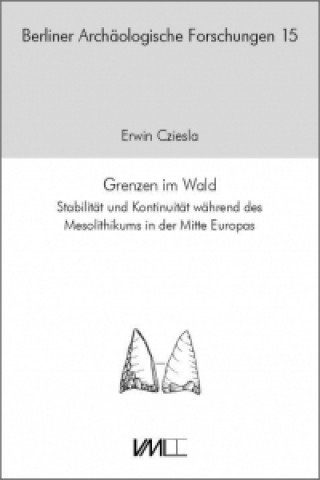
Kód: 12762953
Grenzen im Wald
Autor Erwin Cziesla
Die Darstellung analysiert die kulturellen Verhältnisse später Wildbeutergesellschaften in der Mitte Europas. Ausgehend von der Bearbeitungstechnik an Steinartefakten zeigt sich seit dem späten Präboreal [ab ca. 8.900 v.Chr.] anha ... celý popis
- Jazyk:
 Angličtina
Angličtina - Vazba: Pevná
- Počet stran: 340
Nakladatelství: VML Verlag Marie Leidorf, 2015
- Více informací o knize

Mohlo by se vám také líbit
Informovat o naskladnění knihy
Zadejte do formuláře e-mailovou adresu a jakmile knihu naskladníme, zašleme vám o tom zprávu. Pohlídáme vše za vás.
Více informací o knize Grenzen im Wald
 Anotace knihy
Anotace knihy
Die Darstellung analysiert die kulturellen Verhältnisse später Wildbeutergesellschaften in der Mitte Europas. Ausgehend von der Bearbeitungstechnik an Steinartefakten zeigt sich seit dem späten Präboreal [ab ca. 8.900 v.Chr.] anhand von dorsoventral-basisretuschierten Pfeilspitzen ein Traditionsraum, der Nordfrankreich, die Benelux-Staaten, die Region beiderseits des Rheins bis in die Schweiz umfaßte und sich von den Nachbarregionen absetzte. Diese Großregion blieb in den folgenden Jahrtausenden - während des Boreals und Frühatlantikums - erhalten. Im Spätmesolithikum kam es zu regionalen Ausprägungen, und drei Pfeilspitzentypen ("Rhein-Maas-Schelde-Kultur B", Danubien- und Bavans-Spitzen) besitzen diese dorsoventrale Zurichtung. Gemeinsam bestätigen sie nicht nur das stabile Verbreitungsbild, sondern die Verteilung entspricht der mesolithischen Keramik vom Typ Limburg und La Hoguette. Diese Keramik, bisher von der westmediterranen Cardialkultur abgeleitet, wird nun bezüglich Herkunft mit der westfranzösischen Atlantikküste verknüpft. Auch in der Bandkeramik blieb die Verbreitung stabil, und Ideen eines Miteinanders von Mesolithikern und Neolithikern werden diskutiert. This study analyses the cultural conditions amongst late communities of hunter-gatherers in Central Europe. Considering the working technique of flint artefacts, a distribution area of dorso-ventrally base-retouched arrowheads emerged in the late Pre-Boreal [from ca. 8,900 B.C.] including northern France, Benelux and both banks of the River Rhine up to Switzerland and clearly distinct from neighbouring regions. This major zone remained stable in subsequent millennia - during the Boreal and Early Atlantic periods. In the Late Mesolithic, local subtypes emerged, and three types of arrowheads showed dorso-ventral preparation ["Rhine-Meuse-Scheldt Culture B", Danubian and Bavans points]. Taken together, these do not only confirm the stability of the distribution pattern, but their occurrence coincides with Mesolithic pottery of types Limburg and La Hoguette. This pottery, until now considered a derivate of the Western Mediterranean Cardial Culture, is now connected with the western French Atlantic coast as regards its origin. During the Linear Pottery Culture the distribution remained stable, and notions of a cooperation between Mesolithic and Neolithic populations are discussed.
 Parametry knihy
Parametry knihy
- Plný název: Grenzen im Wald
- Autor: Erwin Cziesla
- Jazyk:
 Angličtina
Angličtina - Vazba: Pevná
- Počet stran: 340
- EAN: 9783896465252
- ISBN: 3896465252
- ID: 12762953
- Nakladatelství: VML Verlag Marie Leidorf
- Hmotnost: 1604 g
- Rozměry: 301 × 217 × 29 mm
- Datum vydání: 02. December 2015
Oblíbené z jiného soudku
-

Dune
249 Kč -

Haunting Adeline
621 Kč -

Berserk Deluxe Volume 2
1092 Kč -

White Nights
71 Kč -

Powerless
268 Kč -

Atomic Habits
330 Kč -

Dune Messiah
228 Kč -

Berserk Deluxe Volume 3
1142 Kč -

One Day
221 Kč -

Berserk Deluxe Volume 1
1115 Kč -

Iron Flame
368 Kč -

Surrounded by Idiots
213 Kč -

Harry Potter and the Prisoner of Azkaban (Minalima Edition)
993 Kč -

Gravity Falls Journal 3
441 Kč -

Heaven Official's Blessing: Tian Guan Ci Fu (Novel) Vol. 1
430 Kč -

The Creative Act
568 Kč -

Dune
276 Kč -

Hunting Adeline
624 Kč -

A Little Life
268 Kč -

Children of Dune
230 Kč -

Heaven Official's Blessing: Tian Guan Ci Fu (Novel) Vol. 2
427 Kč -

Bungo Stray Dogs, Vol. 8 (light novel)
382 Kč -

Percy Jackson and the Olympians 5 Book Paperback Boxed Set
944 Kč -

Solo Leveling, Vol. 1
440 Kč -

The Prisoner's Throne
247 Kč -

Court of Thorns and Roses
206 Kč -

Cry Baby Coloring Book
276 Kč -

Fourth Wing
444 Kč -

Icebreaker
205 Kč -

Berserk Deluxe Volume 6
1089 Kč -

Avatar, the Last Airbender: The Kyoshi Novels (Box Set)
968 Kč -

The 48 Laws of Power
608 Kč -

House of Leaves
611 Kč -

Twisted Lies
213 Kč -

Dune Messiah
277 Kč -

No Longer Human
311 Kč -

48 Laws Of Power
331 Kč -

Twisted Games
213 Kč -

Caraval Paperback Boxed Set
902 Kč -

Solo Leveling, Vol. 2
437 Kč -

Open Circuits
907 Kč -

Berserk Deluxe Volume 5
1119 Kč -

Heaven Official's Blessing: Tian Guan Ci Fu (Novel) Vol. 3
429 Kč -

Berserk Deluxe Volume 4
1125 Kč -

Court of Mist and Fury
206 Kč -

SOLO LEVELING V08
436 Kč -

English File Upper Intermediate Multipack A (4th)
487 Kč -

CHAINSAW MAN V14
254 Kč -

Before the Coffee Gets Cold
198 Kč
Osobní odběr Praha, Brno a 12903 dalších
Copyright ©2008-24 nejlevnejsi-knihy.cz Všechna práva vyhrazenaSoukromíCookies






 Vrácení do měsíce
Vrácení do měsíce 571 999 099 (8-15.30h)
571 999 099 (8-15.30h)